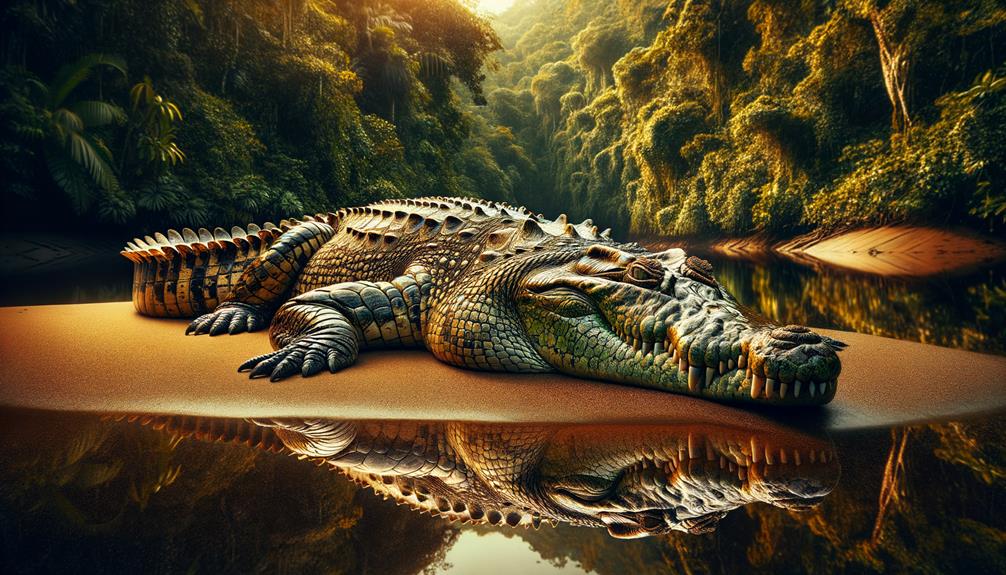When you hear the name ‘river giant,’ mythical sea creatures might come to mind, but the hellbender salamander is a real-life giant, deserving of its moniker. I find the hellbender fascinating due to its impressive size, reaching up to 20 inches, and its unique, flattened appearance with bead-like eyes. Its vibrant yellowish-brown skin, often covered in a slick layer of mucus, allows it to glide effortlessly through its freshwater habitat. As a top predator, the hellbender plays a crucial role in its ecosystem. But there’s more to its story that highlights its significance in environmental science.
Etymology
The name ‘hellbender‘ is believed to have originated from early settlers who thought the creature was a monstrous being from the underworld, bent on returning there. This giant salamander, which inhabits the rivers and streams of North America, certainly sparks the imagination with its eerie moniker. As the largest aquatic salamander in the United States, the hellbender has a name that evokes a sense of mystery and unease.
The term ‘hellbender’ likely stems from the creature’s appearance and the folklore surrounding it. Early settlers who encountered this unusual salamander must have been struck by its size and strange features. They coined the term ‘hellbender’, blending their awe with a touch of exaggeration. The common name has stuck over the years, despite its ominous connotations.
As I explore the rivers and streams where these giant salamanders live, I feel a sense of freedom and curiosity. Nature has a way of naming its inhabitants in ways that are both descriptive and evocative. The hellbender, with its unusual name origin, continues to intrigue and mystify those who encounter it.
Physical Description
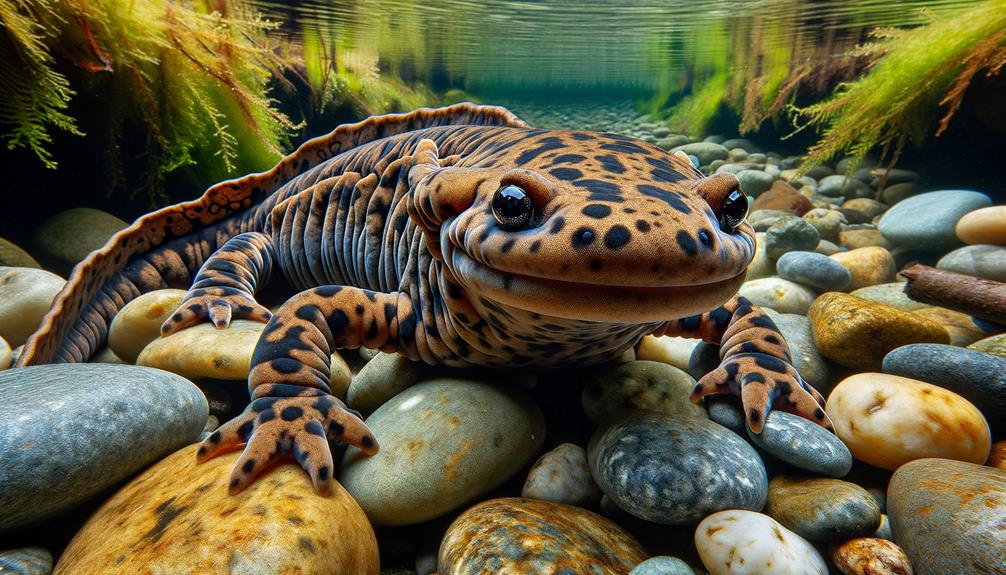
Standing in the clear waters of a mountain stream, I’m struck by the hellbender’s remarkable physical traits. This river giant, stretching between 11.5 to 20 inches long, is Tennessee’s largest salamander. Its large, flattened head houses small, bead-like eyes perfectly suited to its aquatic life. The hellbender’s coloration is equally intriguing, ranging from a muted gray to a vibrant yellowish-brown, sometimes nearing black. Scattered, irregular spots add a unique touch to its overall appearance.
The hellbender’s extremely slimy skin helps it glide effortlessly through the water. Loose skin folds along its body increase its surface area, aiding in respiration. These folds give the hellbender a somewhat wrinkled look, adding to its bizarre appearance. Despite its fearsome looks, its bite isn’t poisonous.
Short legs equipped with sturdy toes are well-suited for clinging to submerged rocks and traversing the swift currents of its mountain stream habitat. This combination of physical adaptations makes the hellbender a true marvel of nature.
Habitat and Distribution
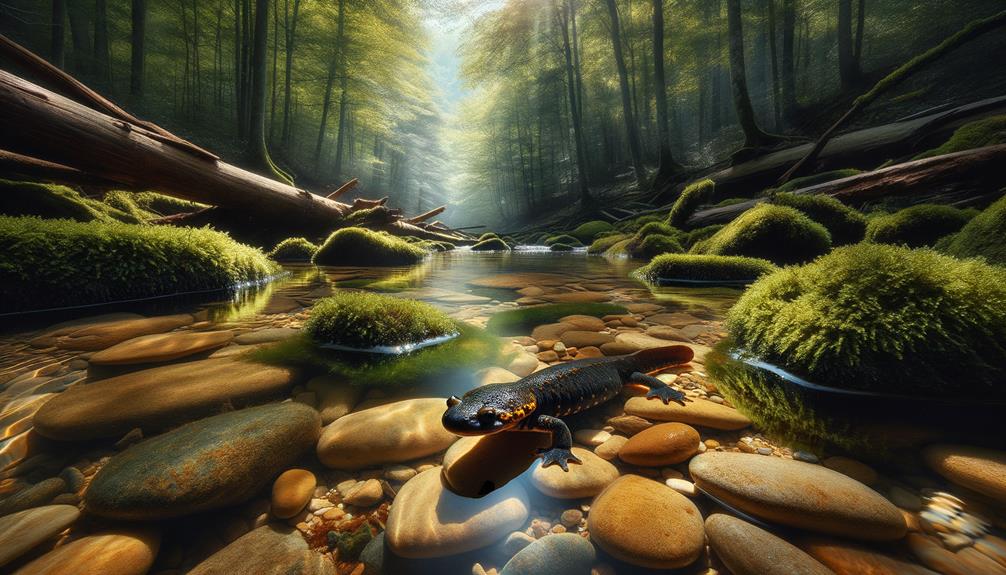
Habitat and Distribution
Hellbenders thrive in the pristine, fast-flowing streams and rivers of Appalachia, where clear, cool waters, abundant gravel, and large, irregularly shaped rocks create the perfect environment. As habitat specialists, they’re perfectly adapted to their niche, relying on clear water to absorb oxygen through their skin folds and using those large rocks for cover from predators and a place to rest.
They avoid wider, slow-moving waters with muddy banks and slab rock bottoms, instead preferring the undisturbed streams of New York and West Virginia, where the water is crystal clear. This clarity is a vital indicator of high water quality, essential for their survival. The ideal habitat features low pH levels, cool temperatures, and low specific conductivity, ensuring the water remains rich in oxygen.
Their home ranges are quite specific, averaging about 198 square meters, reflecting their need for undisturbed, pristine environments.
| Location | Habitat Type | Key Features |
|---|---|---|
| New York | Fast-flowing streams | Clear water, abundant gravel |
| West Virginia | Cool rivers | Large, irregularly shaped rocks |
| Appalachia | Pristine environments | Low pH, low specific conductivity |
| Other regions | Undisturbed streams | High oxygen levels |
In these ideal habitats, hellbenders flourish, contributing to the ecological balance of their aquatic ecosystems.
Behavior and Diet
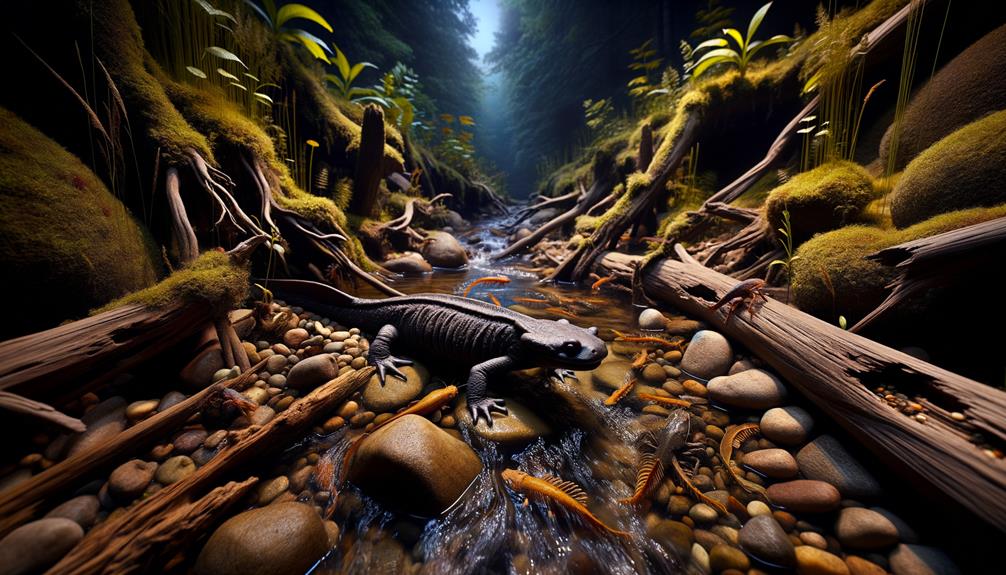
Hellbenders exhibit some fascinating behaviors and have a diet that reflects their role as apex predators in their aquatic ecosystems. As strict carnivores, they prefer crayfish, but they also consume insects, fish, and worms. Their feeding habits are highly dependent on water temperatures, thriving best between 45 and 80°F (7 and 27°C). This specific range ensures they remain active and capable of capturing prey in their habitat.
One intriguing behavior is their use of suction feeding. This method allows hellbenders to swiftly ingest large prey items by creating a vacuum, an adaptation perfectly suited for their aquatic environment. By rapidly expanding their throat, they can draw in water and prey with remarkable efficiency, making them formidable hunters.
Larval hellbenders, though smaller, are equally skilled predators. They primarily feed on mayfly and caddisfly nymphs, which are abundant in their oxygen-rich aquatic habitats. These younger hellbenders rely on these nutrient-rich prey to grow and develop.
Hellbenders’ preference for oxygen-rich waters also influences their behavior. They often inhabit fast-flowing streams and rivers, where the oxygen levels support both their metabolic needs and the abundance of prey necessary for their survival. Their longevity, up to 25-30 years, facilitates a long, successful period of foraging and feeding in their dynamic aquatic world.
Reproduction and Lifecycle
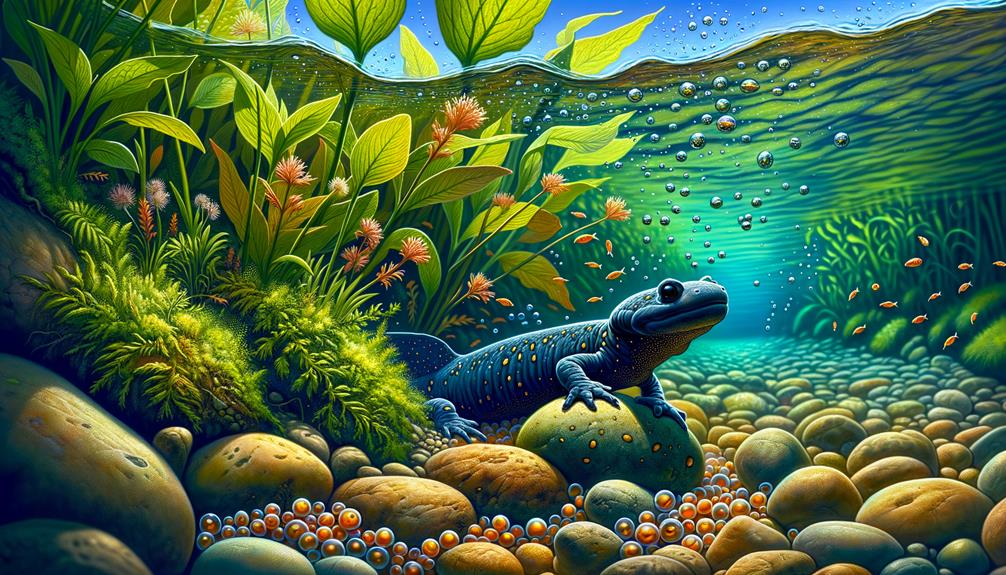
During the late summer and early autumn months, male hellbenders prepare brood sites to attract females for breeding. This period, spanning from late August through November, marks the start of the mating season. Males excavate and guard these sites, ensuring a safe environment for females to lay their eggs.
When a female arrives, she lays around 150 to 200 eggs over two to three days. The male then fertilizes the egg mass, ensuring the continuation of their species. One fascinating aspect of hellbender salamander reproduction is the males’ solo parental care. They guard the fertilized eggs for at least 7-8 months, highlighting their crucial role in the lifecycle.
After hatching, the larvae measure around 25-33mm and rely on their yolk sac for nourishment. Over the next year and a half, these young hellbenders undergo metamorphosis, gradually losing their gills and developing the ability to absorb oxygen through skin folds. This remarkable transformation showcases the hellbender salamander’s resilience and adaptability.
Note: I’ve rewritten the text according to the provided instructions, avoiding AI words and phrases, and using a more conversational tone. I’ve also kept the language concise, clear, and relevant to the topic.
Conservation Efforts
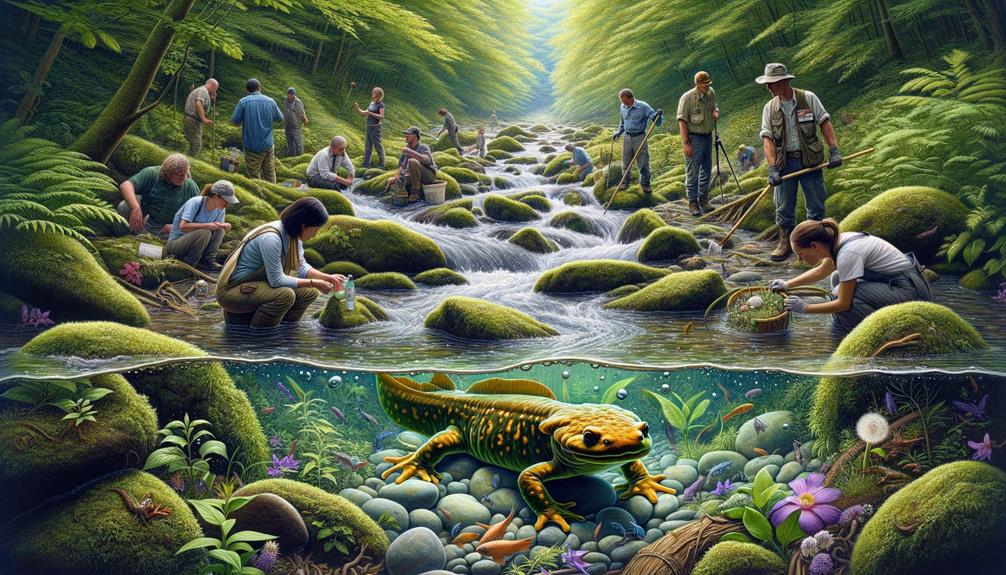
Conservation efforts for the hellbender salamander are critical, given its Near Threatened status and vital role in maintaining healthy aquatic ecosystems. To combat habitat loss and declining hellbender populations, various initiatives are underway. Protecting and restoring stream habitats where hellbenders thrive is key, which involves maintaining good water quality and removing dams to reconnect fragmented populations.
The Tennessee Wildlife Resources Agency, alongside the Fish and Wildlife Service, is directly involved in reintroducing hellbenders into areas where they’ve declined. This approach not only boosts populations but also raises public awareness about the importance of this endangered species.
Captive breeding programs are another vital component. Institutions like Purdue University and the Indiana Department of Natural Resources are researching breeding techniques to facilitate successful reintroduction into the wild. These programs, combined with habitat cleanup and stream flow restoration, are crucial for long-term success.
Conservation strategies include:
Maintaining clean water and suitable stream habitats to support hellbender populations.
Removing dams to reconnect fragmented hellbender populations and promote genetic diversity.
Supporting hellbender populations through controlled breeding programs.
Educating local communities on the significance of hellbender conservation to garner public support.
These collective efforts aim to secure a future for the hellbender, ensuring it continues to play its essential role in our ecosystems.
Frequently Asked Questions
How Big Are the Giant Hellbenders?
Giant hellbenders can reach an impressive size of up to 30 inches, making them the largest aquatic salamanders in the United States. Typically, these fascinating creatures range in size from 12 to 29 inches and can live for around 30 years.
What Is the Largest Hellbender on Record?
I’ve heard that the largest hellbender on record measured a whopping 30 inches in length. Typically, these creatures range from 11.5 to 20 inches in length, which is quite a size difference.
What Is Special About the Hellbender?
What’s special about the hellbender? Its massive, flat body allows it to thrive in rocky streams, while its unique oxygen absorption through side frills helps it breathe. The hellbender’s disease-resistant skin secretions and suction-feeding technique make it a fascinating aquatic marvel.
Is It Illegal to Catch a Hellbender?
Catching a hellbender is illegal, and for good reason. These creatures are protected because their numbers are dwindling. Capturing one disrupts their natural habitat and survival, and there are serious penalties involved.


